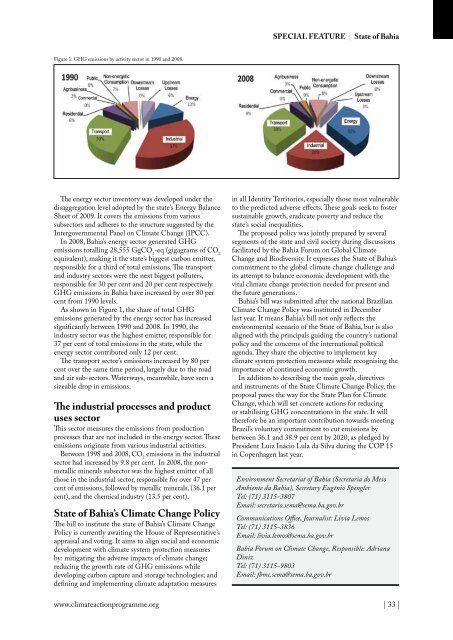Climate Action 2010-2011
You also want an ePaper? Increase the reach of your titles
YUMPU automatically turns print PDFs into web optimized ePapers that Google loves.
SPECIAL FEATURE | State of Bahia<br />
Figure 1: GHG emissions by activity sector in 1990 and 2008.<br />
The energy sector inventory was developed under the<br />
disaggregation level adopted by the state’s Energy Balance<br />
Sheet of 2009. It covers the emissions from various<br />
subsectors and adheres to the structure suggested by the<br />
Intergovernmental Panel on <strong>Climate</strong> Change (IPCC).<br />
In 2008, Bahia’s energy sector generated GHG<br />
emissions totalling 28,555 GgCO 2<br />
-eq (gigagrams of CO 2<br />
equivalent), making it the state’s biggest carbon emitter,<br />
responsible for a third of total emissions. The transport<br />
and industry sectors were the next biggest polluters,<br />
responsible for 30 per cent and 20 per cent respectively.<br />
GHG emissions in Bahia have increased by over 80 per<br />
cent from 1990 levels.<br />
As shown in Figure 1, the share of total GHG<br />
emissions generated by the energy sector has increased<br />
significantly between 1990 and 2008. In 1990, the<br />
industry sector was the highest emitter, responsible for<br />
37 per cent of total emissions in the state, while the<br />
energy sector contributed only 12 per cent.<br />
The transport sector’s emissions increased by 80 per<br />
cent over the same time period, largely due to the road<br />
and air sub-sectors. Waterways, meanwhile, have seen a<br />
sizeable drop in emissions.<br />
The industrial processes and product<br />
uses sector<br />
This sector measures the emissions from production<br />
processes that are not included in the energy sector. These<br />
emissions originate from various industrial activities.<br />
Between 1998 and 2008, CO 2<br />
emissions in the industrial<br />
sector had increased by 9.8 per cent. In 2008, the nonmetallic<br />
minerals subsector was the highest emitter of all<br />
those in the industrial sector, responsible for over 47 per<br />
cent of emissions, followed by metallic minerals, (36.1 per<br />
cent), and the chemical industry (13.5 per cent).<br />
State of Bahia’s <strong>Climate</strong> Change Policy<br />
The bill to institute the state of Bahia’s <strong>Climate</strong> Change<br />
Policy is currently awaiting the House of Representative’s<br />
appraisal and voting. It aims to align social and economic<br />
development with climate system protection measures<br />
by: mitigating the adverse impacts of climate change;<br />
reducing the growth rate of GHG emissions while<br />
developing carbon capture and storage technologies; and<br />
defining and implementing climate adaptation measures<br />
in all Identity Territories, especially those most vulnerable<br />
to the predicted adverse effects. These goals seek to foster<br />
sustainable growth, eradicate poverty and reduce the<br />
state’s social inequalities.<br />
The proposed policy was jointly prepared by several<br />
segments of the state and civil society during discussions<br />
facilitated by the Bahia Forum on Global <strong>Climate</strong><br />
Change and Biodiversity. It expresses the State of Bahia’s<br />
commitment to the global climate change challenge and<br />
its attempt to balance economic development with the<br />
vital climate change protection needed for present and<br />
the future generations.<br />
Bahia’s bill was submitted after the national Brazilian<br />
<strong>Climate</strong> Change Policy was instituted in December<br />
last year. It means Bahia’s bill not only reflects the<br />
environmental scenario of the State of Bahia, but is also<br />
aligned with the principals guiding the country’s national<br />
policy and the concerns of the international political<br />
agenda. They share the objective to implement key<br />
climate system protection measures while recognising the<br />
importance of continued economic growth.<br />
In addition to describing the main goals, directives<br />
and instruments of the State <strong>Climate</strong> Change Policy, the<br />
proposal paves the way for the State Plan for <strong>Climate</strong><br />
Change, which will set concrete actions for reducing<br />
or stabilising GHG concentrations in the state. It will<br />
therefore be an important contribution towards meeting<br />
Brazil’s voluntary commitment to cut emissions by<br />
between 36.1 and 38.9 per cent by 2020, as pledged by<br />
President Luiz Inácio Lula da Silva during the COP 15<br />
in Copenhagen last year.<br />
Environment Secretariat of Bahia (Secretaria do Meio<br />
Ambiente da Bahia), Secretary Eugênio Spengler<br />
Tel: (71) 3115-3807<br />
Email: secretario.sema@sema.ba.gov.br<br />
Communications Office, Journalist: Livia Lemos<br />
Tel: (71) 3115-3836<br />
Email: livia.lemos@sema.ba.gov.br<br />
Bahia Forum on <strong>Climate</strong> Change, Responsible: Adriana<br />
Diniz<br />
Tel: (71) 3115-9803<br />
Email: fbmc.sema@sema.ba.gov.br<br />
www.climateactionprogramme.org | 33 |












